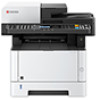Kyocera ECOSYS M2635dw Kyocera Fleet Services KFS Security White Paper - Page 6
What is KFS?, How KFS Works
 |
View all Kyocera ECOSYS M2635dw manuals
Add to My Manuals
Save this manual to your list of manuals |
Page 6 highlights
KYOCERA Fleet Services Security White Paper What is KFS? KFS is a cloud-based device monitoring system that is based on the Software as a Service (SaaS) model. With this solution delivery method, there is no software or network infrastructure investment required. Instead, secure cloud services provide the tools for KFS service providers to centrally control devices, everything from device installation and configuration to reporting and troubleshooting. KFS' powerful suite of utilities enables proactive management of Kyocera and non-Kyocera devices alike, from any computer or smartphone with web browser capabilities. Designed with sophisticated security protocols and policies in place, KFS communication pathways are fully protected. Proactive Service Model Implementation of KFS establishes a "proactive" versus "reactive" service model. Key to a proactive model is KFS' support for email notifications that alert technicians to a device event, system error, toner level or page counts (triggered by the device). The event is described in the email, to enable swift resolution. For example, rather than an end-user requesting service (reactive), the notified technician calls a key contact (proactive). If a technician is dispatched, they are equipped with the necessary replacement parts and/or consumables. By more efficiently utilizing human resources, you maximize device uptime, reduce workflow interruptions and reduce the frequency, duration and cost of on-site service calls; in many cases, service issues are resolved over the phone. Using KFS, valuable device usage insights are gained, enterprise-wide efficiencies are realized, and service-level response objectives are met. How KFS Works KFS collects device status and usage data over a secure connection established between the device and KFS Manager. KFS Manager is the backbone of KYOCERA Fleet Services, and relies on the Microsoft® Azure® cloud system. As the control center for key system features, KFS Manager's intuitive web interface enables a service provider to... • Register and manage users and device groups • Establish configuration settings • Check consumable levels • View real-time device status • Perform maintenance/diagnostics/troubleshooting • Restart (reboot) devices • Upgrade firmware and manage firmware packages • View device counters and properties • Generate list and graphical reports Hosting Environment KFS Manager is hosted on Microsoft Azure, a cloud-based platform that provides a highly-secure server* infrastructure to manage KFS applications; Azure was chosen based on Microsoft's industry-leading commitment to the protection and privacy of data. Microsoft was the first major cloud provider to adopt the new international cloud privacy standard, ISO 27018. In addition to offering multiple layers of security, Microsoft Azure provides complete isolation from all other networks; traffic only flows through customer-configured paths. *Servers are located in the United States. 5|PAGE















